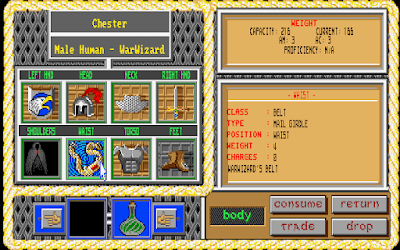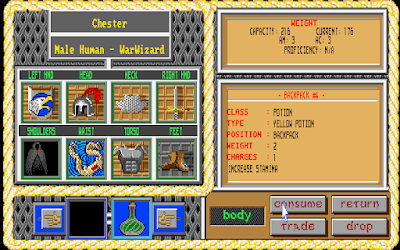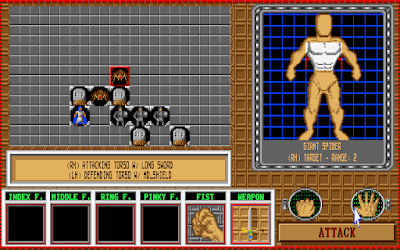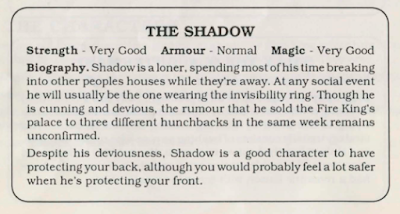 |
| Fixed enemies don't move, so although these two headhunters are ostensibly "guarding" the passage, I don't have to fight them unless I want to. |
In this session, I finished exploring the continent, this time noting where the boundaries transitioned between kingdoms. It turns out that these boundaries are unrealistically straight, even when there are nearby landscape features that would serve as better boundaries. I assume this was done for ease of programming. The kingdoms are arranged into a 2 x 3 grid. The four southernmost kingdoms are roughly square (it may turn out they are exactly square once the water edges are fully mapped). The two northern ones are either compressed on the y-axis or they extend farther north than I've been able to map so far.
Each kingdom has a capital, a handful of other cities, and at least one dungeon (or otherwise non-city place to explore with combats and treasure). Since I have to find nine artifacts, either some dungeons hold more than one or some of them will be found through other means.
A river cuts into the continent from the northeast, nearly reaching the center, where a bunch of adjacent mountain ranges make passage difficult. Because of the rivers and mountains, there's a natural clockwise exploration pattern that starts in northeast Cara (where the game begins) and presumably finishes at Castle Gildain in Aladain, guarded by hordes of monsters.
Once I finished the map, I started over in Cara and began exploring each of the locations more carefully. The game begins at the Hermit's House, nestled in a mountain nook on the road between Little Island and Caer Tiran. I checked in, but the old WarWizard had no new information. North of here is Little Island, which offers a pub, inn, clothing store, and locksmith. An NPC in the pub warns me that the nomads in the faraway deserts are swindlers. Joinable NPCs are all warriors and citizens. The locksmith sells a key to the palace in Cara and a Level 3 lockpick; I purchase both.
Caer Tiran, the capital of Cara, is situated on the north side of a bay. In addition to an inn, pub (citizens, warriors, one cleric, one mage), weapon store, armor store, and temple, the city has the royal palace. There, a guard warns me that his men were forced to destroy the bridge leading to Aladain; you can see the ruins of the old bridge north of the castle. A female wizard says that the castles of Caer Sorith and Car Ereth lie far to the south, off the main road. A solider tells me that Aladain has fallen and "evil runs amok even in the lands to the south." Duke Bendor suggests I seek an artifact of great power in the swamps to the southeast. As covered before, there are no swamps to the southeast; he probably means southwest, where the Caves of Anbari are found in the middle of a swamp. That would make sense, as the Duke of Cara's clue would pertain to a location inside Cara.
The key I purchased in Little Island gets me into a storeroom, where I loot the chests for 394 gold and over 250 food. There are some weapons that I leave (nothing much better than what I have) and a suit of plate mail that I don't have the strength to carry--which is odd, given that I'm supposed to have maximum human strength.
Before attempting the Caves of Anbari yet again, I make a visit to Kaleth in Zebesk. The "legendary" nomad's keep lies on a river bend in the northeastern desert. The town has every service except for a locksmith and stable. It's here that a wizard tells me to take the key from his chest so that I can visit the nomad lords, but then doesn't move so that I can't search his space. There's a chest in the square next to him, but it has nothing in it--or so it seems. Keep reading.
The spell store sells "Awaken," "Tongues," "Protection," "Enhancement," and a Ring of Fireballs. I buy "Protection" not because I want it, but because it's the Level 1 sorcerer spell and I need to get to Level 2 as a sorcerer to be able to cast "Tongues." While exploring, I also purchased "Healing 1" in some other town. You only get 5 spell slots, and you can only memorize spells at inns, but you don't actually have to pay to sleep. Since you get experience for casting spells, it makes sense to find an inn and keep memorizing and casting "Healing 1" until everyone is healthy. This takes as long, and is about as annoying, as repeatedly casting "Cure Light Wounds" in Pool of Radiance.
The process illustrates how the interface is often broken. To cast a spell, you:
- Hit "C" or click the "Cast" button.
- Type or click the number of the character who is casting.
- Click the spell you want to cast.
- Hit the "U" key or click on the "Utter" button.
- Type or click the number of the character the spell is being cast on.
Which of those steps is not like the others? Step 3--it's the only one that forces you to click. Since there are only five spell slots, there's no reason that the creators couldn't have mapped each one to the 1-5 keys, and then casting spells repeatedly would be a relatively quick process of typing C-1-1-U-4 (to cast the first spell on person #4). Instead, the forced clicking interrupts the efficiency of the process.
The good news is that, unlike leveling with weapons, spell leveling is relatively fast. You need 500 spell experience points to get from Level 1 to Level 2 in each of the spell classes. Each casting of a Level 1 spell gives you 30 experience points. I reach Level 3 as a cleric before I know it. By loading up on "Protection" at inns and casting them all in subsequent combats (you can cast up to 3 spells per round), I soon reach Level 2 as a sorcerer, too.
Once I have "Tongues" available, I throw my party back into the Caves of Anbari, determined to make progress. As before, the Caves of Anbari transition to the Caves of Kolin, and the Caves of Kolin have a back exit into a valley, where there is a third entrance to the dungeon of the Ogre King. I am determined to beat my way through the parties of lizardmen, ghouls, and ogres, even if I have to return to town for healing after every single battle.
It turns out that I cleared more of the caves on previous expeditions than I remembered. My real obstacle in finishing the caves is not the enemies but the many locked doors and chests. None of my lockpicking or bashing seems to do any good. Over time, I discover that this is because I've misunderstood some key aspects to the game's interface. In my defense, those aspects are stupid. But my slow discovery of them meant that I end up looping through this set of dungeons about six times.
The earliest thing I discover has to do with secret doors. An NPC in the dungeon alerts me to their possibility. To find them, you have to bash your way into blank walls. You may not discover them the first time, so if you really suspect there's a secret door there, you want to do it repeatedly. I am initially confused when I enter the Cave of the Ogre King, defeat one party of guards, and find a blank room with no treasures or exits, but I discover a secret door (which I cannot open) on the east wall.
Frustrated at all the doors and chests I can't open, I leave the caverns, save the game, and spent about 40 minutes rushing from town to town to figure out which locksmith sells the best pick. This turns out to be the one at Tel Keliok in Essea. I reload, head directly there, buy the Level 8 pick, and return to the dungeon. It does get me through some of the doors, including four of them in a "jail" area, each of which has stacks of NPCs behind them. Only one of them gives any kind of hint (the artifact in the caves is a belt), but the others include clerics and wizards who will join the party if I feel like taking the time to rearrange things.
(One of the other major discoveries of this session is that when you encounter "an NPC," you may in fact be encountering a stack of up to 8 NPCs. You can see how many there are based on how many buttons are active on the left-hand side of the screen. Typically, only the top NPC has anything interesting to say, if any of them do, but the others might include races and classes that you want to enlist in your party. Until this session, I'd only ever noticed the "top" NPC.)
 |
| The top NPC is giving me this clue, but there are six more NPCs in this "stack." Incidentally, I've yet to have an occasion to "bribe" or "threaten." |
More successful use of the lockpicks gets me some cool treasure, including a short sword +2, a Potion of Charisma (permanently improves charisma by 1), leather boots +1, and a robe +2 for a mage. But I still can't get through other doors, including the one in the Ogre King's chambers.
I'm just about to give up when, during some random clicking on a chest I've already explored, I figure out what I've been missing. It turns out that when you open chests, you do not by default see any keys the chests contain. You only see other "items." To see keys, you have to click on the chest icon above the window that show's the chest's contents. I thought you only had to click on that if you wanted to use a key on a chest, but apparently you also need it to see what keys a chest contains.
 |
| . . . and this is the "key" view. |
It gets worse. When you loot enemy corpses, there are actually three views of their potential items: backpack, keys, and body. The entire game, I've only been looting the items on the "backpack" screen, and then wondering why lizard men who attacked me with long swords +1 never seemed to have long swords +1 once I killed them.
There are keys everywhere in the Caves of Anbari, Kolin, and the Ogre King. Everywhere. I've just been missing them. Lockpicks and bashing are entirely unnecessary: there's a key to every door and chest. Screaming with frustration, I finally find the key to the Ogre King's lair and use it to get through the secret door and a second door beyond.
The climactic battle with the Ogre King is fairly easy. He attacks alone, and while he hits hard, no single enemy is that threatening. My party of warriors winnows him down, and pretty soon I loot the WarWizard's Belt from his body. I at last have one of the nine artifacts.
 |
| That's one gaudy-looking belt. |
That wraps up the land of Cara. I make my way next to Zebesk. In fact, I've already been using one of its towns, Forest Glen, located just off the main road, to rest in between visits to the Caves of Anbari. In addition to an inn and pub (which all towns have), it has a stable, and more out of curiosity than anything else, I buy a horse. I guess it cuts down on food use and makes you fatigued less quickly, but you can't ride them through forests or deserts. This makes me reflect on the fact that many RPGs offer horses, but in most of them, they're more trouble than they're worth because you're always having to mount or dismount to explore and fight (and remember where you left them). The best approach I've seen to horses is in Darklands, where once you buy them, they're just in the background. It's assumed you use them when you travel but otherwise you don't have to micromanage them.
MiddleGate is practically across the road from Forest Glen, but it offers a spell store and a clothing store. There are some leather boots +1 I can buy for the rest of my party once I feel like I have enough gold. An NPC in the pub tells me: "Near Caer Ereth lies a hidden valley surrounded by impenetrable mountains. Therein lies a hidden settlement that no one has seen for a thousand years. Many think there is great treasure there!" North of Caer Ereth, there is such a valley, but I have no idea how to enter it. There are several mountain ranges that seem to completely encircle large bits of land. Maybe I'll eventually find something that lets me fly.
 |
| I suspect he's talking about this area of my map. |
I return to the nomad city of Kaleth, and lo-and-be-goddamned-hold, there is a key in that chest in the wizard's room. You just have to know how to search chests for keys. I suspect the same issue is behind Rangerous's inability to find a key in a drawer. And we were speculating that the game had already been "played!" All those chests we thought were "empty" weren't really empty; they were just empty of "items," which is the default view and doesn't include keys.
Ironically, my eighth-level lockpick gets me through the door that the wizard's key opens. It takes me into the royal palace, past some royal guards, up some stairs, and into some rooms with some fantastic loot. There are some light helmets +1, a magic collar +1, and potions of Increase Wisdom and Increase Stamina. The latter improves hit points for all my body parts by 2; it's the most significant character development in the game so far. Oddly, some of the potions I find are things like "Damage Self" and "Decrease Wisdom" and "Decrease Strength." Even more oddly, the merchant in town sells such potions. I can't imagine what use they have. I don't think you can use potions offensively.
 |
| "Increase Stamina" potions is the only way to give a permanent boost to maximum hit points. |
In the throne room, I meet the four Nomad Lords, who together recount the history of the WarWizards and say that a piece of the armor can be found in the jungles to the south.
The "jungles to the south" have a ruin called the Temple of Alor, dedicated to a minotaur god. I have been here before, but it looked like a small corridor leading to a rounded apse with an altar and a single combat with "headhunters."
It turns out there is a secret door on the east side that opens into a sprawling labyrinth (suitable for a minotaur god, I guess) of corridors and rooms, and plenty of fixed combats with headhunters, apes, gargoyles, giant spiders, ghouls, and wights.
 |
| Wights are so keen to cast "Protection" on themselves and "Unprotect" on us that they sometimes forget to actually attack. |
I've gotten mostly used to combat. It still takes far too many commands to make a simple attack, but it's amazing how fast you can get used to typing something like UP ARROW-UP ARROW-N-N-T-UP ARROW-A-R if you do it enough times. I've been waiting for a more detailed combat posting for when I have more advanced spells.
I should mention that reloading is still fairly common. My warriors are pretty hardy, but all it takes is two lucky hits in a row to knock someone's head or torso hit points down to 0. Having to return all the way to town when something like that happens feels like too much of a penalty. There are also plenty of times in which I enter a fixed battle, find 8 foes, die amidst their swarms of attacks, reload, re-enter the same battle, and find only 1 foe.
 |
| You'd think that giant spiders would poison you, but I never got poisoned. |
We soon get lost in the huge dungeon, but we continue following the right wall. As if the size isn't enough, the temple introduces a new navigation element: teleporter pads. There are occasional emergency exits to the wilderness with no way back in. At times, the dungeon seems to be pranking me; one long spiraling corridor, full of multiple combats, ends in nothing more than a single square with a sign that says, "Have a nice day!"
There are some nice treasures. I find a long sword +2, a chain mail +1, two Wands of Lightning, and an "Increase Dexterity" potion. There are several "Great Heal" potions with at least two uses, which helps restore hit points after my "Healing 1" spells run out. Scrolls give me the "Flame Touch" and "Aid Travel" spells.
Finally, we make it to an inner area marked by a sign that reads: "Ahead lie the chambers of the god Alor. Woe to those who enter unbidden." A room full of teleporter puzzles led to a couple of large minotaur battles. Minotaurs attack with throwing axes, which they can do from three squares away, but otherwise they die faster than you'd expect given their fearsome reputation.
The minotaur god, Alor, stands alone on a podium next to an altar. He attacks alone, too. He has a war hammer +3, and he hits hard, but as with the Ogre King, there's only so much damage a single enemy can do before four characters are able to kill him. On his body, I find the WarWizard's Boots, the second of the nine artifacts.
Now that the water finally seems to be flowing with this one, it's probably time to think about my party composition. I've been running with three (unnamed) warriors, which worked out well in the early game, but it would be nice to have more diversity. It's probably time to enlist a cleric and wizard before I waste too much character development on characters I'll probably abandon. On the other hand, with spellcasters only getting five spell slots before they have to find an inn to rest, maybe it makes sense to just stick with warriors. This is where I'd normally ask for opinions, but I seem to be the only documented person to have played the game this far.
Time so far: 27 hours









































